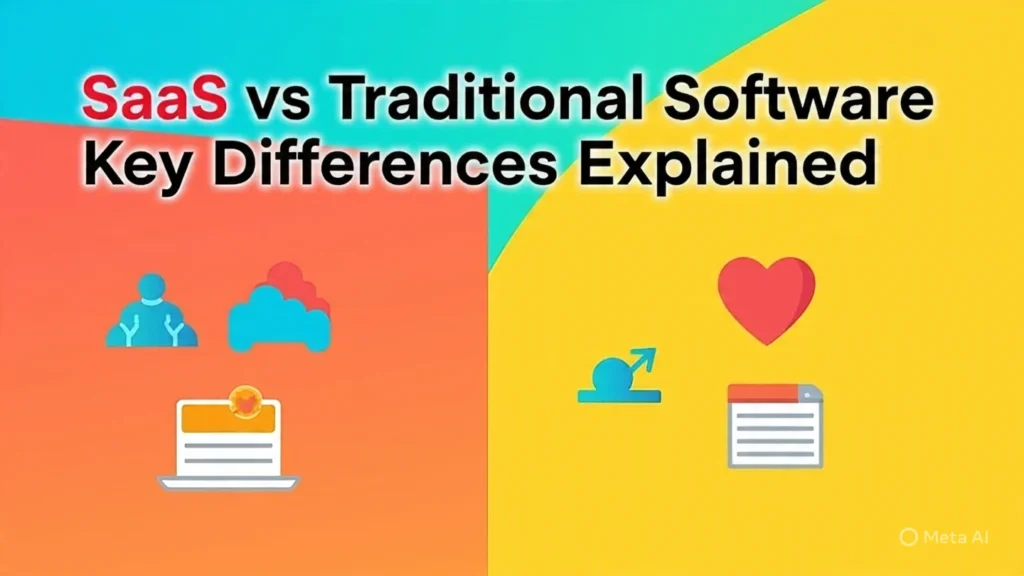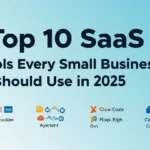1. Introduction
Hello Doston aaj Ham aapko SaaS vs Traditional Software Key Differences Explained karenge. Aaj ke digital zamanay me software model ka sahi chayan karna har business ke liye bahut important ho gaya hai. Cloud computing ke aane ke baad SaaS vs traditional software ka debate aur bhi zyada popular ho gaya hai.
Chaahe aap ek startup ho ya ek badi company, ye samajhna zaroori hai ki dono models me kya fark hai aur kaunsa aapke business ke liye best rahega.
Is guide me aapko milega dono ka detailed comparison, pros & cons, use cases aur 2025 me kaunsa model lena chahiye – iska clear answer.
2. What is SaaS (Software as a Service)?
SaaS yaani Software as a Service ek cloud-based model hai jisme software ko aapke computer me install karne ki zarurat nahi hoti. Bas aapko internet browser se login karna hota hai, aur aap software use kar sakte ho.
Popular SaaS examples:
- Google Workspace (Docs, Gmail, Drive)
- Zoom
- Salesforce
- Dropbox
- Canva, Shopify
Key Features:
- Koi installation ki zarurat nahi
- Automatic updates milte hain
- Monthly/Yearly subscription pe based
- Kisi bhi device se access ho sakta hai

3. What is Traditional Software?
Traditional software, yaani ki on-premise software, wo hota hai jo aapke computer ya local server me install kiya jata hai. Ye ek baar purchase kiya jata hai aur uska license aapke paas hota hai.
Popular traditional software examples:
- Microsoft Office (offline version)
- Adobe Photoshop (older versions)
- CorelDRAW
- QuickBooks Desktop
Key Features:
- Local system par installation required
- Updates manually karne padte hain
- One-time license cost
- Internet ki zarurat nahi hoti (mostly)
4. Key Differences Between SaaS and Traditional Software
| Feature | SaaS | Traditional Software |
|---|---|---|
| Deployment | Cloud-based | Local system par install hota hai |
| Accessibility | Web browser se kahin se bhi | Sirf jis device me install hai |
| Cost Structure | Subscription-based (monthly/yearly) | One-time license cost |
| Maintenance | Vendor handle karta hai | User ya IT team handle karti hai |
| Scalability | Easy to scale | Hardware limitations hoti hain |
| Updates | Automatic updates | Manually update karna padta hai |
| Customization | Limited (vendor ke upar) | High customization possible |
| Internet Dependency | Hamesha required | Mostly nahi hoti required |
5. Advantages of SaaS
- Low Initial Cost: Aapko ek saath bada paisa nahi dena padta, monthly subscription hoti hai.
- Automatic Updates: Software hamesha latest version me hota hai.
- Remote Access: Kahin se bhi access kar sakte ho – laptop, tablet, phone.
- Scalability: Aap easily naye users add ya remove kar sakte ho.
- Faster Setup: Install karne ki tension nahi, turant use shuru kar sakte ho.
6. Disadvantages of SaaS
- Internet Required: Bina internet ke aap software access nahi kar sakte.
- Ongoing Cost: Subscription fee lagataar chalta rahta hai.
- Vendor Control: Aapke data aur software par pura control vendor ka hota hai.
- Data Security Concerns: Data remote server par hota hai, jo kuch logon ko risky lagta hai.
7. Advantages of Traditional Software
- Complete Control: Aapke system me install hota hai, data bhi aapke paas.
- One-Time Cost: Ek baar license lo, use karte raho.
- Offline Use: Internet ke bina bhi kaam karta hai.
- Customization Friendly: Business ki needs ke hisaab se customize kar sakte ho.
8. Disadvantages of Traditional Software
- High Upfront Cost: Shuru me license aur setup kaafi mehenga padta hai.
- Maintenance Burden: Aapko ya aapki IT team ko updates aur backups sambhalna padta hai.
- Updates Manual: Automatic nahi hote updates.
- Limited Access: Sirf ek device ya network par access hota hai.
9. When to Use SaaS vs Traditional Software
| Scenario | Best Option |
|---|---|
| Startup ya Small Business | SaaS |
| Remote ya Hybrid Teams | SaaS |
| Low IT Support wali Companies | SaaS |
| High Security Requirements wale firms | Traditional Software |
| Poor Internet Connectivity | Traditional Software |
| Large-scale Customized Systems | Traditional Software |
10. Cost Comparison: SaaS vs Traditional Software
- SaaS: Kam shuruaati kharch, lekin long term me recurring cost lagataar hoti hai.
- Traditional: Ek baar mehenga license, lekin fir maintenance ka kharcha kam hota hai.
Example:
- SaaS CRM: $30/user/month → $360/year per user
- Traditional CRM: One-time license $1000/user → Long-term cost-efficient ho sakta hai
Business ka size aur usage pattern cost decision me bahut important role play karta hai.
11. Security & Compliance
- SaaS Security: Vendors high-end security dete hain, par aap unke upar depend karte ho.
- Traditional Software Security: Aapke paas pura control hota hai, lekin responsibility bhi aapki hoti hai.
2025 me kai SaaS providers ISO, GDPR, HIPAA jaise compliance follow karte hain, lekin sensitive industries ke liye traditional approach better ho sakti hai.
12. Performance & Reliability
- SaaS: Internet connection fast ho to performance best hoti hai.
- Traditional: Local hardware par based hota hai, isliye speed control me hoti hai, but hardware failure ka risk hota hai.
Kuch sectors jaise graphic design, engineering me traditional software better perform karta hai.
13. Future Trends: What to Expect in 2025 and Beyond
- Hybrid Models: SaaS + Traditional ka combination adopt ho raha hai.
- AI-Enabled SaaS: Automation, insights aur smart decision making ke tools integrate ho rahe hain.
- Edge Computing: SaaS aur bhi fast aur reliable ban raha hai.
- Low-Code SaaS Tools: Non-tech log bhi applications create kar pa rahe hain.
Future me flexibility aur scalability ko dhyan me rakhte hue SaaS ka trend aur grow karega.
14. Conclusion: Which One Should You Choose?
SaaS vs Traditional Software ka decision aapke business needs, budget, team structure aur infrastructure par depend karta hai.
Agar aap startup ho ya cost-conscious business ho jisko scalability aur flexibility chahiye, to SaaS best choice hai.
Lekin agar aapke paas strong IT team hai, aur aapko full data control chahiye, to traditional software better ho sakta hai.
- SaaS vs Traditional Software Key Differences Explained (2025 Guide)
- Top 10 SaaS Tools Every Small Business Should Use in 2025
- What is SaaS? Ek Beginner’s Guide to Software as a Service in 2025
- Cryptocurrency aur Trading ki Duniya: Ek Romanchak Safar
- Best Multivitamins for Men and Women in India
15. Frequently Asked Questions (FAQs)
1. What is the main difference between SaaS and traditional software?
SaaS cloud-based hota hai jo browser se access hota hai, traditional software aapke device me install hota hai.
2. Is SaaS always cheaper?
Short term me haan, lekin long term me subscription cost zyada ho sakti hai.
3. Can SaaS work offline?
Mostly nahi, lekin kuch tools limited offline access dete hain.
4. Is traditional software more secure?
Agar properly manage kiya jaye to haan, lekin responsibility aapki hoti hai.
5. Which model is better for small businesses in 2025?
SaaS – kyunki yeh cost-effective hai aur easy to manage bhi.


